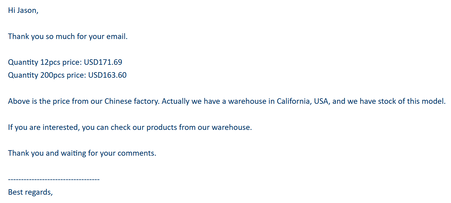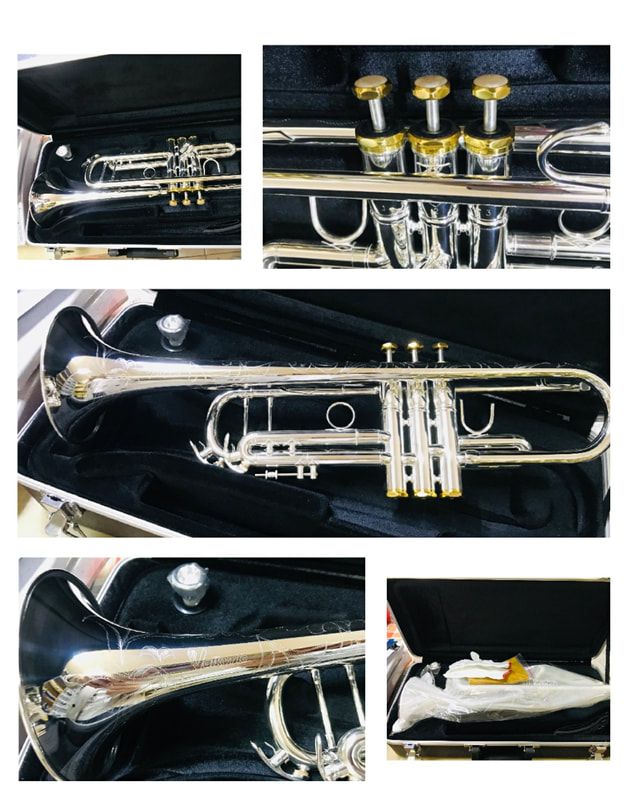|
Many people tell me that I have no right to criticize those in the music industry for profiting at the expense of cheap laborers in other countries. I'm told, "this is none of your business, focus on your work and leave China and India alone." First, yes, I do have the right to criticize what is destroying most of our industry and I feel obligated to say something. I see what happens behind the scenes that most consumers are completely oblivious to because I'm given information that is unavailable to the general public. If you want 95% of all instruments to be inexpensive crude copies of skillfully crafted high end instruments, then this post is not for you. Second, think about the people working in the factories producing these instruments. What is the goal of the factory owners (The People's Republic of China)? To make as many trumpet looking objects (or clarinets, tubas, keyboards, etc.) as possible in as little time as possible? Why? Because China's goal is to destroy the companies that supply high quality goods throughout the world in an effort to become the greatest super power. And they are doing this at the expense of the health, wellness, and happiness of their own people. Don't believe this their goal? Look it up. It's been happening for decades and as I write this today, Amazon, Walmart, and thousands of online retailers are aiding this agenda through their own efforts to profit from cheap imports. We choose to be blind to this problem because we like to have more "stuff" rather than higher quality. Third, how does profiting from pre-made, branded imports serve the consumer if this tactic puts the high quality competitors out of business? What you are left with is just one option, the same inexpensive products that do not perform on the level necessary to meet our definition of value. If an object costs 1/10th the price, are you going to buy 10 of them over your lifetime to meet the expectations of one high quality competing product? Probably not. You're more likely to never achieve the satisfaction, reliability, durability, quality engineering, design, materials, etc. even if you purchased 100 of the cheaper products. I posted some of this content on my Facebook page to get a feel for where my audience sits on this seemingly controversial subject. Honestly, I don't know how or why there is controversy. Would you want your son or daughter to find the cheapest low quality vehicle to take to his/her first year of college? We perceive quality for very good reasons and making these decisions can have a real impact on our lives. I'm not saying you need to buy a new BMW or Cadillac for your graduating senior, but sending them to school in the car with the lowest safety ratings is another story. Here are a few questions that may evoke a response and make us think...
What we choose is what we become. I spent several years of my childhood living in a semi-truck and many more living in a low income trailer court on the outskirts of town. When I was a kid, my parents probably took me to McDonald's for my birthday more than once. I understand that many of us do not have the luxury to choose high quality options every time. Do we have the ability to choose quality over quantity where it really matters? Even on a budget? Having made thousands of custom trumpets for individual clients, I have witnessed first hand the high percentage of low income trumpet players who choose the highest quality instrument. I have also noted a fair number of high income trumpet players purchasing the highest quality instruments. More (relatively) low income trumpet players buy custom Harrelson trumpets than any other income level. That really tells you something. Do you know who usually asks questions, kicks the tires, but never buys a high end trumpet? The middle class! So many people are convinced that having 12 inexpensive trumpets is better than having one or two high end trumpets, yet they come back and kick the tires again and again. I had a prospective client call me last year during the pandemic asking about a new Muse MMXX trumpet. This person had made hard inquiries on my instruments many times over the past 10+ years, but never made a purchase. He asked me if I would consider a trade towards the Muse. I asked him what he had in mind. He proceeded to tell me that over the past ten years, he has purchased a knock-off Harrelson from China, a knock-off Flumpet from China, and a knock-off Taylor, again from China, and many other inexpensive trumpets. He said, "I'm convinced none of these are as good as a Harrelson so I'd like to trade all of them for $8000 value", which is approximately what he had invested in them. In those ten years, he never spent $200 for a round trip ticket to visit our shop and try our trumpets. The deal didn't work out and, as far as I know, he still does not have a Harrelson trumpet. Why should I pay for all of his poor purchase decisions by taking them in trade. Do you know how much a second hand knock-off of a Flumpet or Harrelson sells for on the used market? Around $600 on a good day. The quality of knock-off trumpets is extremely low in comparison to the original products they attempt to copy. It's sad to see people promote them to their students in social media groups because the dimensions, solder, solder joints, materials, and workmanship are beyond questionable. They don't come anywhere close to matching a student line Yamaha trumpet. And for that matter, a 60-year-old Olds Ambassador is 20 times better than one of these trumpet objects. Do they look nice from the outside? Usually, but it truly is what is inside that counts.  An actual quote I received from a factory in China this week. Name or logo of my choice may be engraved on these instruments. An actual quote I received from a factory in China this week. Name or logo of my choice may be engraved on these instruments. I've posted the actual quote I received from the factory so everyone can see how easy it is to make $500 profit on them. There are many dealers having their company name (or some made up name) engraved on these and making huge profit margins at the expense of both the consumer and those working in factories. These factories are unsafe (in pretty much every way), provide very little pay for their effort, and do not care about their employees. Supporting cheap Chinese junk is exactly why it exists along with all the associated humanitarian problems. My rant is far from over. I started this discussion with my friends and family when I was in 6th grade. This is when I first discovered the vast differences between cheap and great. I vowed to be an inventor and had over 50 inventions scratched into my notebook by the time I was 12 years old. I built Harrelson Trumpets out of my passion for great engineering innovations and I will continue my quest as this work is extremely satisfying.
If you need an inexpensive trumpet, think first about who made it and why? Was it made by someone who loves their work? If not, are you encouraging the opposite by supporting a company with different values than yourself? Would a second hand instrument made with great skill, care, and shared values be a better option? There are millions of high quality used trumpets (and other musical instruments) available on the market that will play easier, last longer, and bring more joy than a brand new knock-off import. Try an Olds Ambassador or a Getzen. Kanstul made a great number of French Besson trumpets. There are so many great used options. Or have a repair tech improve, repair, upgrade a pro instrument that has seen better days. The more we support something, the more it will exist in our lives. And to be clear, I have nothing against imports! There are so many great options available in this world and most of them come from outside of North America. I'm 100% invested in tools, machinery, and equipment made in other countries. It's all about choosing what aligns with our values regardless of the "normal sized" price tag. If you want to jump on every low priced item, you are racing to the bottom of the barrel and you will eventually win along with everyone who chooses quantity over quality.
13 Comments
A lot of people have opinions on Heavy Bottom Caps! But what is the truth? How does science explain what we experience when adding inertia to the bottom of the valve casing? It just so happens that I have invested a fair amount of time, energy, and money finding the answers to these questions. The results are not surprising to some, but unbelievable to others. Today, I'll share with you the psychology behind this controversial subject. First, let's define a few things. Inertia is the subject of today's discussion so we'll start there. By searching for the definition of "Inertia" on google, I get the following: a property of matter by which it continues in its existing state of rest or uniform motion in a straight line, unless that state is changed by an external force. "the power required to overcome friction and the inertia of the moving parts" This definition is quite vague so let's move to the definition of Inertia according to Isaac Newton's first law: Newton’s first law states that if a body is at rest or moving at a constant speed in a straight line, it will remain at rest or keep moving in a straight line at constant speed unless it is acted upon by a force. In fact, in classical Newtonian mechanics, there is no important distinction between rest and uniform motion in a straight line; they may be regarded as the same state of motion seen by different observers, one moving at the same velocity as the particle and the other moving at constant velocity with respect to the particle. This postulate is known as the law of inertia. We will use this basic definition as it gives us enough parameters to apply to the inertia value within an acoustic brass musical instrument. There really is more to it, but the basics will be more than enough to get us started. So what happens when you add an ounce of brass (or any other material) to the bottom of your valve casing? If it is secured tightly (usually with threads), this added mass increases the inertia of the valve casing. And the added inertia reduces the amount of standing wave energy that is transferred into vibration energy. This results in increased standing wave energy to the bell, which increases resonance and amplification. In general, stability of some notes will be improved both on attack and sustain, potential for dynamic range increases, and potential for achieving the natural overtone series of the entire closed system increases. What does that mean? It will be easier to play the note. It will be easier to hold the note. The note will be closer to the tone color as defined by the tapers and linear relation to air volume within the oral cavity, mouthpiece, leadpipe, and bell. When I refer to the "note", I'm using a generalization to describe any pitch or pitches affected by the added inertia and resulting added resonance within instrument specific to the location of the anti-nodal high pressure zones within the tubing, pistons, valve casings, etc. This anti-nodal high pressure is present on every pitch beginning with the fundamental and increases in number as we move up to each higher partial. The fundamental creates one anti-node in the center (linear length) of the instrument. The next partial creates two anti-nodes, equally spaced between the nodes, which are the ends of each wave form. The second partial creates three equally spaced anti-nodes and so on. Any note that creates an anti-node near thin material tubing or features may set that material into vibration if the energy is sufficient to overcome the inertia in that area. Since higher partials have more anti-nodes, we have ever-increasing potential for material vibration as we play higher notes. By adding inertia, in the form of mass or some other mechanical design, the transfer of energy at anti-nodes can be reduced or completely eliminated. Harrelson trumpets were designed and engineered from the ground up to solve the low inertia problem. And heavy bottom caps existed over one hundred years before I was born. Someone understood and applied this theory long before my great great grandparents were alive. I simply rediscovered the basic theory of inertia and how it pertains to resonating musical instruments in 1992. This is not something I invented nor do I take any credit for the theory. But I have invested nearly 30 years into the application of this theory to achieve MBR, which is Maximum Bell Resonance. Hopefully, this explanation opens your eyes to the physics side of "heavy bottom caps" and maybe even gives you a glimpse into what is possible. Imagine a trumpet where anti-nodal high pressure zones have no affect on the energy potential of the standing wave and the bell resonates at its full potential. What would the world be like if we were all playing instruments that expressed every bit of energy we so lovingly put into them? Here's a video diving deeper into this subject... |
Jason Harrelson
Inventor, Musician, Educator and Founder of Harrelson Trumpets, Trumpet Momentum and Harrelson Momentum. Archives
July 2024
|



 RSS Feed
RSS Feed
